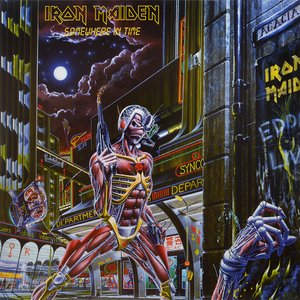Published on Sep 15, 2004
Somewhere In Time marked a series of changes for Iron
Maiden. This was their first disc to utilize guitar and bass
synthesizers – something akin to admitting publicly you cheated on
your SATs, especially when earlier Iron Maiden albums had
emblazoned in their liner notes the words “NO SYNTHESIZERS!!!”.
This also was the disc which marked their follow-up to their
superstardom, courtesy of
Powerslave and
Live After Death, so anything they would release would be
examined with the musical version of the electron microscope.
Going into this review (and I’m working off of the re-issue from
1998), I admit there’s a soft spot in my heart for this particular
album. It was the first Iron Maiden record I ever bought (probably
followed the next week by
Live After Death), and was one of a handful of records which
marked my embracing of the heavy metal genre as a teenager. So
while there are some people who view this disc as an unwelcome
change for Bruce Dickinson and company, there’s a part of me which
will always think highly of it.
All of that said, nearly 20 years since its release,
Somewhere In Time has held its own quite well, though there
is a bit of listlessness in it, especially in subjective
songwriting. More on that in a minute.
The major point of contention many people have with this disc is
the use of synthesizers – and, had they been overused in the course
of the disc, I’d agree. But their introduction to Iron Maiden’s
sound – at least to my tired, old ears – actually helps to enhance
things a bit. There’s no need to fear that the old Maiden sound has
been pitched into the trash along with the bell bottoms and Bay
City Rollers 8-tracks; there’s plenty of bass thumping from Steve
Harris and fluid guitar solos from Dave Murray and Adrian Smith. If
anything, the controlled use of the synthesizers brings out the
individuals’ importance in the band more than anything.
The two hits off this disc, “Wasted Years” and “Stranger In A
Strange Land,” are indeed worthy of the attention given to them –
but the true gem in this collection is “Heaven Can Wait,” a track
which has become a live staple of Iron Maiden’s show. This is
another example of how Iron Maiden can write an epic song (if
memory serves me right, this one clocked in at eight minutes)
without wasting a second on unnecessary fluff. Each note seems to
have an urgency of its own, pushing the song to a frantic finale.
The choral bridge (mostly made up of Dickinson’s vocals) is a
haunting moment in this song.
For all of the praise one can lavish on
Somewhere In Time, there is a slight hint that the
foundation might have had a hairline crack. Iron Maiden, to this
point, had always been able to write songs with solid subject lines
– airplane dogfights, passage of the dead in Egypt, poems which
made us gag in high school but they somehow made to sound cool. On
Somewhere In Time, the subject matter grows a tad thin, as
songs like “Déjà Vu” and “The Loneliness Of The Long
Distance Runner” just don’t have the same kind of snap that one had
come to expect from the band by this stage in their career.
Likewise, while “Alexander The Great” is an entertaining song, it
almost feels like the group tries to cram too much history into one
song – anyone else remember Monty Python’s “Oliver Cromwell”?
Still,
Somewhere In Time has remained a solid Iron Maiden release
and, unlike many other albums from this period in time, sounds as
fresh today as it did when it was first released. Did it live up to
expectations the band created thanks to
Powerslave and
Live After Death? No – but, in all honesty, it would have
been asking a lot to top that experience. What this album did do –
something no one realized at the time – was close out an important
period of Iron Maiden’s career, something one would discover just
one album later.
